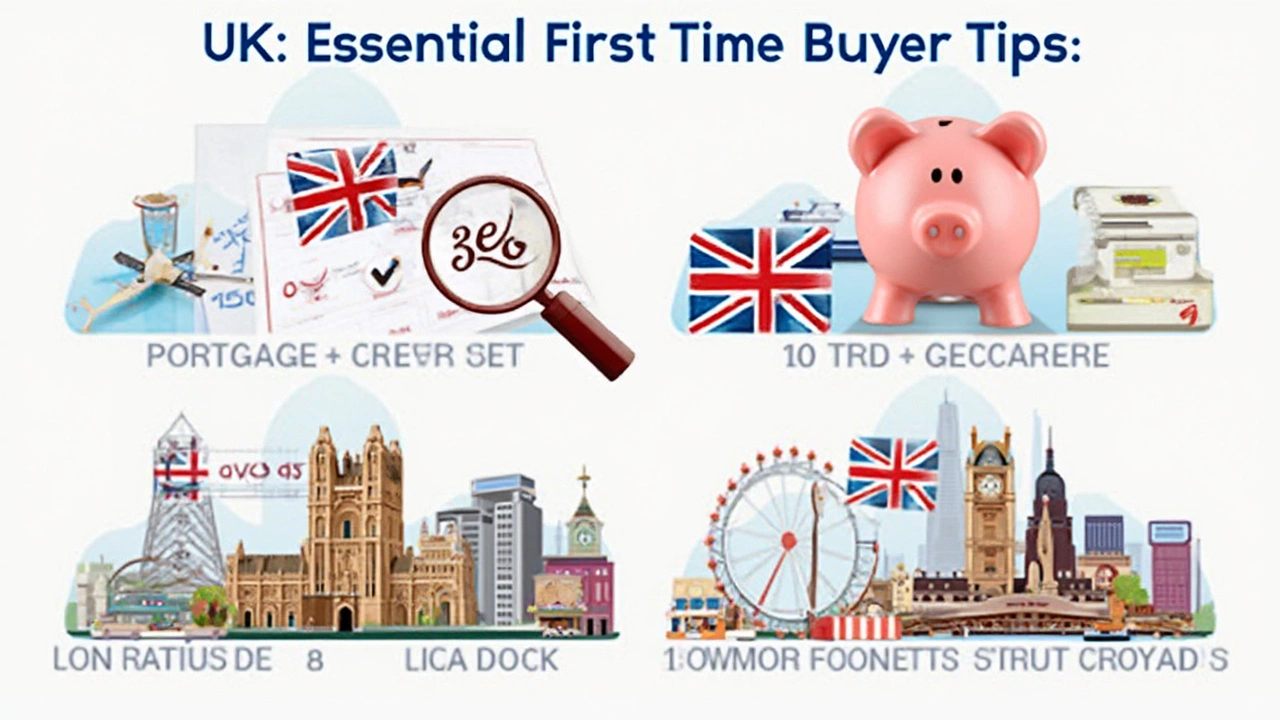Best Banks for First Time Home Buyer Programs: What You Need to Know
 Apr, 29 2025
Apr, 29 2025
So you’re eyeing that first house and wondering which bank actually wants to help you—not just pad their pockets. Picking a lender isn’t about who throws out the lowest rate on their website. It’s about getting a deal that really makes sense for newbies: lower down payments, fewer surprise fees, and a team who won’t treat every question like you’re clueless.
Here’s the truth: some banks love first-time buyers because they know you’ll probably stick around. That means special deals you might miss if you just wander into your current branch. We're talking things like zero down payment options, grants for closing costs, or programs that look past a not-so-perfect credit score. Even if your savings account looks a little empty (thanks, rent and avocado toast), there are legit ways to get approved—and not just by the 'big name' banks, either.
The real challenge? Not getting blinded by flashy ads or promises that seem too good to be real. You want to know what to ask, what red flags to dodge, and why smaller neighborhood lenders sometimes throw in perks you won’t find elsewhere. Stick around to find out which banks are actually on your side—and how to play the system so you don’t end up broke before move-in day.
- What Makes a Good First Time Home Buyer Program?
- Big Banks vs. Local Lenders: Who Delivers More?
- Top Banks for First Time Home Buyers in 2025
- Hidden Costs and Perks: What They Don’t Tell You
- Tips for Getting Approved on Your First Try
What Makes a Good First Time Home Buyer Program?
Not every program is built the same, and if you’re a first time home buyer, you want features that really work for beginners. So, what should you be looking for? The biggest things are low down payment requirements, decent interest rates, help with closing costs, and guidance through the whole process. Banks that offer flexible credit checks (so a late student loan from five years ago doesn’t kill your dream) are gold.
Some programs let you put down as little as 3%, while others might require nothing if you qualify for special government-backed loans like FHA or VA loans. Pay attention to whether the bank offers any grants or forgivable loans—many do, but they might not advertise them loudly. For example, Bank of America’s “Community Affordable Loan Solution” had zero down payment and zero closing cost options in select neighborhoods last year. These are the kinds of deals you want to sniff out.
Don’t forget about the small print. Some programs come loaded with extra fees. Others have rates that spike after your first payment. You’ll want to compare:
- Minimum down payment (the less you pay upfront, the better for cash-strapped buyers)
- Interest rates (watch for fixed vs. adjustable)
- Closing cost help (grants, credits, or rolled into the loan)
- Credit score requirements (not everyone has perfect credit)
- Extra perks (cash back, free homebuyer classes, or even a dedicated adviser)
Check out this quick breakdown of popular program features for first time home buyers:
| Feature | Why It Matters |
|---|---|
| Low Down Payment | Lets you buy sooner without saving for years |
| Closing Cost Grants | Cuts your upfront costs by thousands |
| Flexible Credit Checks | Gives second-chance to buyers with past issues |
| Rate Locks | Keeps your loan affordable if rates go up while you shop |
| Education Programs | Prepares you for surprise costs and paperwork |
If you see these features, you’re on the right track. Make sure to ask about all of them when you visit a bank or lender. The best programs don’t just throw cash at you—they try to make your new life as a homeowner way less stressful.
Big Banks vs. Local Lenders: Who Delivers More?
When you start shopping for your first home loan, you’ve probably got the big-name banks on your radar: Wells Fargo, Bank of America, Chase, you know the ones. They’re everywhere, so it feels kind of safe. They often offer streamlined online applications, tons of customer support, and a pretty predictable process. Some, like Bank of America, run their own first time home buyer programs with pretty solid perks—think down payment grants up to $10,000 or discounts on closing costs. But get ready for stricter rules on your credit score and income. Big banks love good paperwork.
Here’s where things get interesting: local lenders, credit unions, or even neighborhood branches of regional banks. They don’t have the mind-blowing marketing budgets, but they seriously compete for your business if you’re a rookie buyer. Credit unions and community banks often score high for personal attention. You’re not just a number. They’ll sometimes stretch further for you—even if you’ve got a few dings on your credit or not a huge down payment. Plus, they might hook you up with special local or state programs, like the popular FHA-backed loans or custom deals just for people living in their area.
- Big banks may offer bigger down payment assistance, slicker online platforms, and more loan officers if you prefer everything digital.
- Local lenders may look past a spotty credit history, answer your panicked calls quickly, and actually know what’s happening in your housing market.
- Credit unions often have lower rates and fees, but you might have to jump through a few hoops to join.
If you’re into numbers, here’s a quick bite:
| Lender Type | Average Down Payment Required | Median First-Time Buyer APR (2025) |
|---|---|---|
| Big Banks | 3% - 5% | 6.1% |
| Credit Unions/Local | 3% (with more grants) | 5.7% |
Bottom line: Don’t just pick a bank by its logo. Take the time to shop around, ask both big banks and small lenders about their actual first time home buyer deals, and see who treats your situation with real care. Sometimes the underdog lenders pull off bigger wins for people starting out than the giants ever will.

Top Banks for First Time Home Buyers in 2025
Not all banks roll out the welcome mat for first time home buyers, but a few names keep coming up when people actually close on their starter homes without getting burned. Below are banks and credit unions that have solid reputations for easy-to-understand loans, decent rates, and deals you wouldn’t expect unless you did your homework.
- Bank of America: Their “America’s Home Grant” gives up to $10,000 toward closing costs and counts zero for your down payment if you qualify. They also push their Community Affordable Loan Solution, which ditches the credit score minimum and is built for first-timers in certain locations. Their digital application platform makes things way less confusing.
- Wells Fargo: Despite some shaky headlines in the past, they’re serious about helping first-time buyers. Their Dream. Plan. Home. program gives you a straight-up $2,500 grant for down payment or closing costs, no strings if you meet income limits and buy in designated areas. Plus, they work with a ton of first-time buyer grants in different states.
- Chase: With their Homebuyer Grant, you can reel in up to $5,000 in select communities. Their DreaMaker Mortgage only requires 3% down and gives breaks on private mortgage insurance (that annoying extra fee many banks won’t lower for new buyers). They also have homebuyer education resources, which actually break down the process so you don’t feel lost.
- Ally Bank: If you like doing everything online (no suit required), Ally's digital platform lays it out clearly. They offer as low as 3% down with no lender fees—seriously, $0 for processing or application. They also move faster than most banks, so you’re not left hanging for weeks waiting for a yes or no.
- Local Credit Unions: Don’t skip these. Many credit unions team up with state or city first-time buyer programs—think down payment assistance, cash help for closing, or lower rates. Places like Navy Federal or your city’s teachers credit union usually have membership perks that make their loans less expensive over time. Not every mortgage officer will tell you about this, so ask directly.
Here’s a snapshot of what some of these banks are offering right now, based on what buyers actually scored in early 2025:
| Bank/Credit Union | Minimum Down Payment | Grant/Assistance Amount | Standout Feature |
|---|---|---|---|
| Bank of America | 0% - 3% | Up to $17,500 | Layered grants, no minimum credit score in select areas |
| Wells Fargo | 3% | $2,500+ | Wide state-to-state grant network |
| Chase | 3% | Up to $5,000 | DreaMaker program lowers PMI costs |
| Ally Bank | 3% | N/A | No lender fees; totally online process |
| Local Credit Unions | 0% - 3% | Varies (sometimes over $10,000) | Perks for members, stacked state/local incentives |
Here’s a tip: check if you or someone in your family is eligible to join a credit union—police, nurses, teachers, even certain big employers all qualify. The right program could cut thousands off what you pay upfront. Don't take whatever your usual bank says at face value; shop around, ask about state-backed programs paired with your mortgage, and run the numbers carefully. The small print and the real help are never in the same place.
Hidden Costs and Perks: What They Don’t Tell You
Everyone talks up the sweet perks you get as a first time home buyer, but let’s be real—there’s a laundry list of hidden costs that can ambush you if you’re not looking. Most banks show off their flashy down payment deals, but the fine print about closing costs, private mortgage insurance (PMI), and random fees? Not so much.
Let’s break down where your money might slip away before you know it:
- Closing Costs: You’ll hear this term a lot. Appraisal fees, credit reports, title insurance, and legal fees all pile up. The average closing costs in the U.S. are $6,905 for a $350,000 home, according to ClosingCorp’s 2024 report.
- PMI Payments: Put less than 20% down and you’re almost definitely paying PMI. This adds anywhere from 0.5% to 1.5% to your loan amount each year. It’s not peanuts—think hundreds extra every month.
- ‘Origination Fees’: These are just fees for creating your loan. Some banks waive them for first time home buyers, some sneak them in. Always ask for the list up front.
- Homeowner Association Dues: If your new digs are in a community with a HOA, that’s another monthly bill people forget about.
- Escrow Account Calls: Banks may require you to pre-pay several months of property tax and insurance into an escrow account.
Then there’s perks banks do a pretty poor job advertising:
- Down Payment Assistance: Some banks work with state and local programs to hand out grants—real money you don’t pay back.
- Discounted Fees: Special pricing for first time home buyer loans can save a chunk in upfront costs (but always check if it’s baked into a higher interest rate later).
- Homebuyer Education: Completing a short online class can knock down your loan rate or even qualify you for more assistance.
Here’s a good tip from Bankrate:
"First-time homebuyer programs can make a noticeable difference, but you need to read the fine print on eligibility and all fees involved."
Some banks, like Wells Fargo or Bank of America, might offer a $7,500 closing cost grant in certain cities, but you need to live in the property for at least three years to keep the cash. Local credit unions sometimes toss in even better deals, especially if you work with a local realtor.
Want a side-by-side on some of these costs? Here’s what often gets missed:
| Cost/Perk | Common Amount | Where to Find |
|---|---|---|
| Closing Costs | $4,000 - $10,000 | All lenders |
| PMI | 0.5% - 1.5% of loan/year | If down < 20% |
| Down Payment Grant | $2,500 - $7,500 | Big/niche banks, local programs |
| Discounted Origination Fee | Varies | First-time-buyer loans |
| Homebuyer Course | Lower rates | Banks/credit unions |
Kicking the tires on a first time home buyer program? Always ask for a full breakdown—not just the perks, but every fee and condition. That’s how you keep your budget (and your sanity) in check.

Tips for Getting Approved on Your First Try
Nobody likes jumping through endless hoops, especially when you’re trying to lock down your first place. Good news: getting the green light on your first time home buyer loan isn’t some impossible feat—if you play it smart from the start.
First off, check your credit. Lenders want to see you’ve paid your bills on time. Most home loan programs for newbies ask for at least a 620 credit score, but the best deals usually go to folks above 700. If your score looks shaky, pay down small debts or challenge those weird collection notices before applying. Even a 20-point boost can mean thousands less in interest.
Banks are nosy. They’ll want to see pay stubs, W-2 forms, bank statements, and proof you have steady income. Avoid big purchases before you close—no new cars or splurges on designer shoes. Every lender hates surprises, especially when it means less cash in your account.
Don’t have stacks saved up for a down payment? Ask the bank about down payment assistance programs—many offer help for first time home buyer folks, and you don’t have to pay it back. Some programs from places like Bank of America or Wells Fargo even toss in grants up to $10,000 if you qualify (usually if you meet income requirements or buy in certain neighborhoods).
- Get pre-approved, not just pre-qualified: Pre-approval means the bank has actually checked your details, not just taken your word.
- Limit job changes: Lenders want to see at least two years at your current job. If you’re planning a move, do it after you close.
- Ask about "no PMI" options: Some banks drop private mortgage insurance (PMI) if you fit their special first time buyer profiles. That can save you $100 to $200 a month.
- Keep your paperwork organized: Anything fishy—like a random $3,000 in your account—will make lenders nervous. Be ready to explain, or better yet, keep your finances simple while applying.
Want to see how banks stack up for your personal story?
| Bank | Typical Minimum Credit Score | Down Payment Requirement | Average Processing Time |
|---|---|---|---|
| Chase | 620 | 3% | 35 days |
| Wells Fargo | 600 | 3% | 30 days |
| Local Credit Union | 580 | 0-3% | 32 days |
| Bank of America | 620 | 3% | 33 days |
One last tip: always ask if there’s a special first time home buyer department or team at your chosen bank. The folks who work with newbies every day can push your application through faster—and help explain the random letters or requests that pop up.